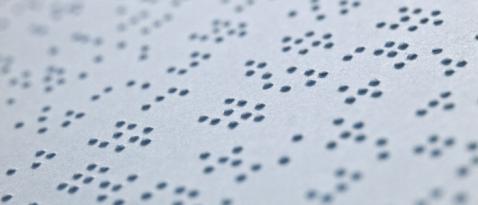How does a blind person use technology?
Kristen Shinohara, '06, teamed with Dr. Josh Tenenberg to research how blind people use, or are frustrated by, assistive technologies.
This Section's arrow_downward Theme Info Is:
- Background Image: ""
- Theme: "light-theme"
- Header Style: "purple_dominant"
- Card Height Setting: "consistent_row_height"
- Section Parallax: ""
- Section Parallax Height: ""
UW Tacoma researchers put devices to the test

A study by UW Tacoma alumna Kristen Shinohara '06 and Institute of Technology associate professor Josh Tenenberg made the cover of the August issue of Communications of the ACM, the flagship magazine of the Association of Computing Machinery, the largest organization for computing and information technology professionals in the world. The magazine has a circulation of more than 90,000.
The article, "A Blind Person's Interaction with Technology," grew out of Shinohara's capstone research project for her master's degree. She got the idea from a friend who is blind, and teamed up with Tenenberg, who has expertise in this area. "We combined my experience in conducting empirical studies and background in cognitive science with her driving curiosity and experience in professional software development," he explained.
"We worked closely throughout the data collection and analysis, and wrote collaboratively. But Kristen conducted all of the interviews and was largely responsible for the qualitative analysis and unearthing the key design implications."
Shinohara and Tenenberg presented their research at a conference on computers and accessibility in 2007, where it was well received. The conference's organizers nominated their paper for consideration in Communications, and the magazine's editors invited them to rewrite the article for publication.
As far as Tenenberg knows, it is unprecedented for a graduate student's research project to be selected for publication in Communications, let alone for the cover story.
As a master's candidate at UW Tacoma, Shinohara studied how a blind college student uses various kinds of technological devices, some designed to help visually impaired people, others used by both sighted and blind users, such as a desktop computer. She studied the student's interactions with a number of technologies, including software used to read a website page out loud, a labeler that prints Braille, and a talking wristwatch.
But the website reader was slow and frustrating. The labeler was inadequate. And the talking watch was just obnoxious.
The subject found it very time consuming to find the information she wanted using the website reader. She kept getting lost and having to start over again.
The labeler worked fine when she wanted to put a Braille label on the buttons of a microwave or on a CD case, but she wanted to give a CD that she had made to a sighted friend, who didn't read Braille.
Her talking watch told the time just fine, but she didn't like that it called attention to her. She preferred a silent watch that she could read with her fingers.
The unusual study caught the attention of those in the field of information technology accessibility, partly because the subject was studied in her own home, doing things she normally does, rather than in a laboratory setting.
"This study was very close to the user. They aren't usually done to this depth," Shinohara said. She postulated that the devices didn't always suit the subject's needs because they were difficult, unpleasant or inappropriate to use within a given physical or social context.
"Much digital technology design is focused on the product itself, designed far from the people who use it," Tenenberg said. "Often, computer users are brought in only at the end, when usability testing is done. Sometimes this comes so late in the product development lifecycle that a design team cannot afford to ask if anyone even wants this thing."
Shinohara and Tenenberg's project was based on "the perspective that designers have to get out of the computer lab, go to people's lived-in environments and spend time with them. They have to understand the people for whom they are designing," Tenenberg said. "We looked at what this technology means to the subject, how it constrains and enables her participation in the physical and social world."
For example, the designers who made the labeler never considered that people who are sighted might need to read the labels, he said.
What the engineers sometimes forget, Shinohara explained, is that you can't merely substitute one mode of interaction for another.
"We have examples of plenty of designs for products that are annoying, harmful and wasteful," Tenenberg said. "Designers can't simply rely on taken-for-granted assumptions about people, especially people who are different from them."
He said, "Because of their malleability and low-cost, digital artifacts [devices] have the potential to be of great service to large numbers of people. But you have to get out of the computer lab, as Kristen did."
Currently Shinohara is a doctoral student at UW Seattle, working on motor impairment accessibility studies with Dr. Jacob Wobbrock, assistant professor at The Information School. She said she'd like to continue working in this vein.
"Kristen is among the hardest working students I have ever encountered," Tenenberg added.
Recent news
Main Content
Gathering Strength
News Tags on this arrow_upward Story:
- None
Main Content
UW Tacoma Enrollment up 4% for Autumn 2024
News Tags on this arrow_upward Story:
- None
Main Content
Celebrating First Gen
News Tags on this arrow_upward Story:
- None



